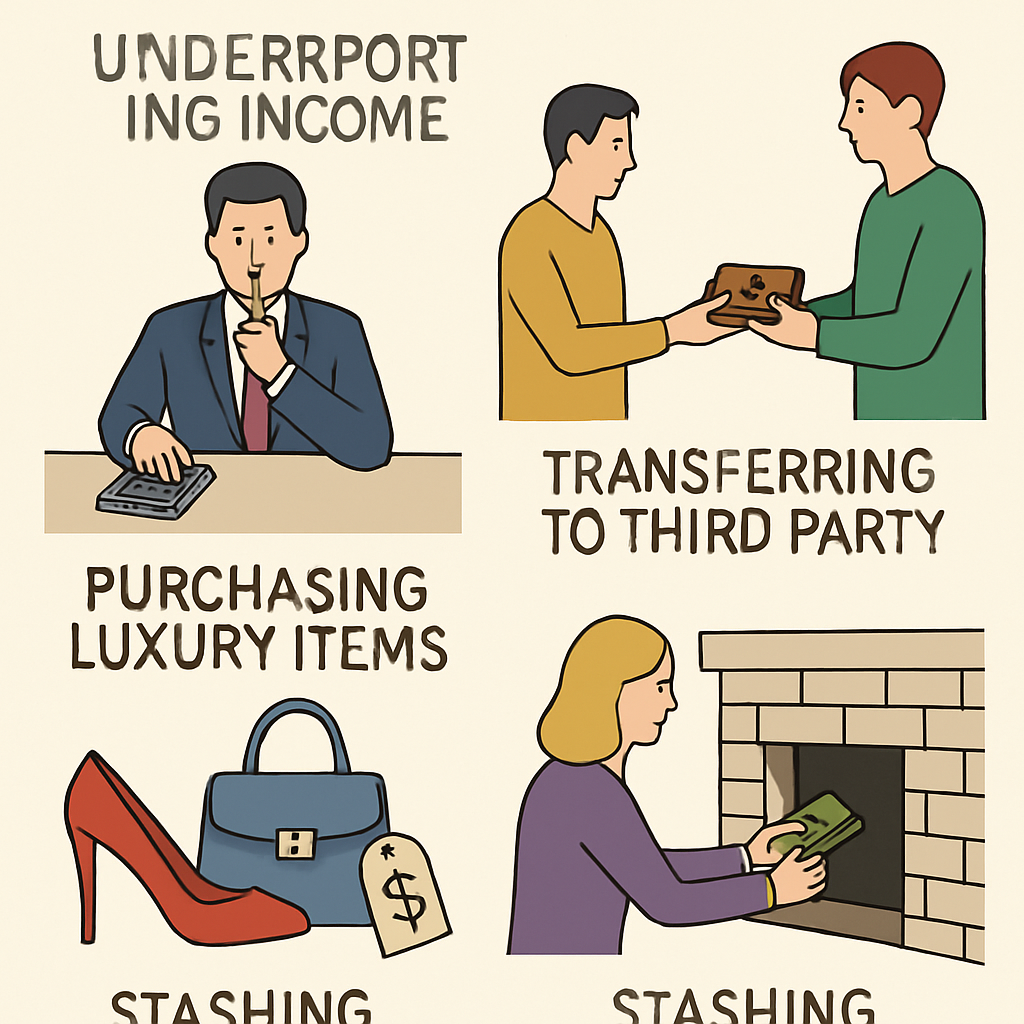Divorce can be a complex and emotional process. It often involves the division of assets, which can be contentious. Some individuals may consider hiding money to protect their interests. However, this action carries significant legal risks.
Hiding assets during a divorce is illegal. It can lead to severe penalties, including fines and loss of credibility in court. Transparency is crucial for a fair division of marital assets.
Understanding the legal implications of asset concealment is essential. This article explores the consequences and offers insights into legal asset protection strategies. By staying informed, individuals can navigate divorce proceedings more effectively and ethically.
Understanding Marital and Separate Assets
In a divorce, understanding the difference between marital and separate assets is crucial. Marital assets are usually accumulated during the marriage. These include income, properties, and other financial gains shared by both spouses.
Separate assets, on the other hand, belong to one spouse. They include assets acquired before marriage or through inheritance. Knowing which category each asset falls into is vital for fair asset division.
Here’s a simple list to differentiate:
Marital Assets: Joint bank accounts, shared properties, shared investments.
Separate Assets: Pre-marital investments, inheritances, gifts.
This distinction can influence how assets are split in a divorce. It helps determine what each spouse is entitled to receive. Legal advice is often necessary to classify assets accurately and fairly.
Common Methods of Concealing Assets in Divorce
Some individuals resort to hiding assets to gain an edge in a divorce. While illegal, these practices are unfortunately not uncommon. Understanding them can help parties safeguard their interests.
One method involves transferring money to friends or family. This approach masks the financial trail temporarily. However, it can unravel under scrutiny.
Underreporting income is another tactic. Spouses might do this by hiding cash or failing to disclose bonuses. This method can mislead the courts about actual earnings.
Creating fake debts is also a common ploy. A spouse might claim they owe money to a friend, reducing perceived assets. This tactic complicates divorce proceedings.
Typical means of asset concealment include:
- Transferring money to trusted individuals.
- Underreporting salary or additional income streams.
- Fabricating debts to decrease asset visibility.
Such deception brings serious legal risks. Discovering these tactics typically involves financial experts. Courts take asset concealment seriously, imposing severe penalties.
Legal Consequences of Hiding Money in Divorce
Hiding money during divorce can backfire disastrously. It not only jeopardizes personal integrity but also attracts severe legal penalties. Courts view asset concealment as a breach of trust.
When deception is discovered, the offending spouse faces serious repercussions. They may be ordered to pay fines or even face contempt of court charges. These penalties serve to deter dishonest behavior.
Beyond fines, hiding assets can impact the divorce settlement. Courts might award a larger share of assets to the non-offending spouse. This act serves to compensate for deceitful tactics.
Furthermore, asset concealment damages credibility. Courts could dismiss testimony from a dishonest party in future proceedings. This loss of credibility can have long-lasting effects.
The legal consequences of hiding assets include:
- Fines and monetary penalties.
- Contempt of court charges.
- An unfavorable divorce settlement.
- Loss of credibility in court.
Transparency is paramount in divorce. Courts advocate for honesty to ensure fair outcomes. The risks tied to asset concealment often outweigh any perceived benefits.
How Courts Uncover Hidden Assets
Courts employ various techniques to identify hidden assets in divorce cases. This ensures fairness in asset distribution. These methods are comprehensive and effective.
Forensic accountants play a pivotal role in this process. They analyze financial records with keen expertise. Their goal is to find discrepancies and omissions.
Moreover, subpoenas are a legal tool frequently used by courts. These compel the release of financial documents. Banks and financial institutions must comply and provide detailed reports.
Courts also utilize private investigators when necessary. These professionals can uncover assets through discreet observations and inquiries. Their findings often lead to critical discoveries.
Common court methods for uncovering hidden assets include:
- Employing forensic accountants.
- Issuing subpoenas for financial documents.
- Hiring private investigators.

These strategies highlight the importance of financial transparency. Attempts to hide assets will likely be discovered. Trust in legal processes is essential for a fair divorce settlement.
What Assets Cannot Be Split in a Divorce?
Certain assets are typically excluded from division during divorce. These are often categorized as separate property. Understanding these can prevent disputes.
Assets acquired before the marriage usually remain separate. Inheritances are also typically retained by the original recipient. Some gifts can fall into this category, depending on state laws.
A detailed inventory of assets is crucial. It helps in distinguishing between marital and separate property. Accurate records streamline the divorce process.
Commonly excluded assets include:
- Property owned before marriage.
- Inheritances received by one spouse.
- Specific personal gifts, depending on their origin.
Knowing what assets cannot be split aids in clear negotiations. It is vital to consult legal advice to navigate these distinctions correctly.
Legal Ways to Protect Assets During Divorce
Protecting assets during a divorce requires strategic planning. Legal methods help avoid pitfalls and ensure fairness.
One effective way is establishing trust. Trusts can shield assets if set up before marriage issues. It’s crucial to plan early for maximum protection.
Legal agreements like prenuptials are valuable. They define asset division terms, reducing potential disputes. They are enforceable and provide peace of mind.
Financial transparency is fundamental. Honest disclosure of all assets facilitates fair division. It reduces risks of penalties or sanctions.
Here are some methods to legally protect assets:
- Establishing irrevocable trusts.
- Creating prenuptial or postnuptial agreements.
- Financial disclosures and transparent dealings.

Consulting with legal and financial advisors is important. They guide asset protection while ensuring compliance. Proper legal advice safeguards interests and aids smooth divorce proceedings.
The Role of Trusts and Prenuptial Agreements
Trusts play a vital role in protecting assets during divorce. By placing assets in a trust, individuals can often keep them separate. However, timing is critical; trusts must be established well before marital troubles to be effective.
Prenuptial agreements also offer substantial protection. They clearly outline how assets are handled and divided. These agreements prevent disputes and protect individual interests, especially in high asset divorces.
Key elements of prenuptial agreements:
- Clear asset identification and valuation.
- Specification of asset division.
- Spousal maintenance terms.

Both trusts and prenuptial agreements require proper legal structuring. Legal professionals ensure these documents are valid and compliant with laws. By planning ahead, individuals safeguard their assets and promote fair outcomes in divorce.
High Asset Divorce: Special Considerations
High asset divorces are often more complex. They involve significant wealth and intricate financial portfolios. Specialized legal and financial advice is essential in these cases.
The complexity of these divorces comes from various factors. Business interests, multiple properties, and diverse investments need careful handling. Each asset requires proper valuation and division.
Key considerations in high asset divorces:
- Accurate valuation of luxury items and properties.
- Protecting business interests and intellectual property.
- Handling complex investment portfolios.
Proper legal expertise ensures fair asset division. It safeguards each party’s financial interests. Specialized knowledge is crucial for navigating the intricacies of high asset divorces.
How to Find Hidden Assets in Divorce
Uncovering hidden assets can be a challenge. However, there are effective strategies to locate them. Employing professionals is often necessary.
Forensic accountants play a vital role. They delve into financial records to reveal discrepancies. This forensic analysis can expose concealed wealth.
Key strategies to find hidden assets include:
- Investigating financial statements for inconsistencies.
- Using subpoenas to access essential documents.
- Hiring private investigators for thorough asset tracking.
Technology also aids in revealing hidden assets. Digital trails, such as emails and online transactions, can provide clues. This approach ensures a transparent divorce process.

The Importance of Transparency and Legal Advice
Transparency in divorce is vital. It creates trust and simplifies the asset division process. Open communication ensures a fair resolution.
Legal advice provides clarity on complex issues. An attorney guides you through legal requirements and asset protection. Understanding these elements helps avoid future disputes.
Key benefits of transparency and legal advice include:
- Ensuring a fair and equitable settlement.
- Minimizing costly legal battles and delays.
- Protecting long-term financial interests.
These practices create a smoother divorce process. They also support lasting peace and compliance with legal standards.
Conclusion: Fairness, Compliance, and Long-Term Security
Navigating a divorce with transparency and legal guidance leads to equitable outcomes. When parties are honest, divisions become less contentious and more efficient. Fairness in the process is not just ethical; it protects long-term security.
Choosing not to hide assets prevents legal consequences and promotes future stability. Complying with the law ensures peace of mind and maintains credibility. Focusing on fair asset distribution benefits all involved, securing financial health beyond divorce. With careful planning and professional advice, individuals can face divorce challenges confidently and protect their interests.













